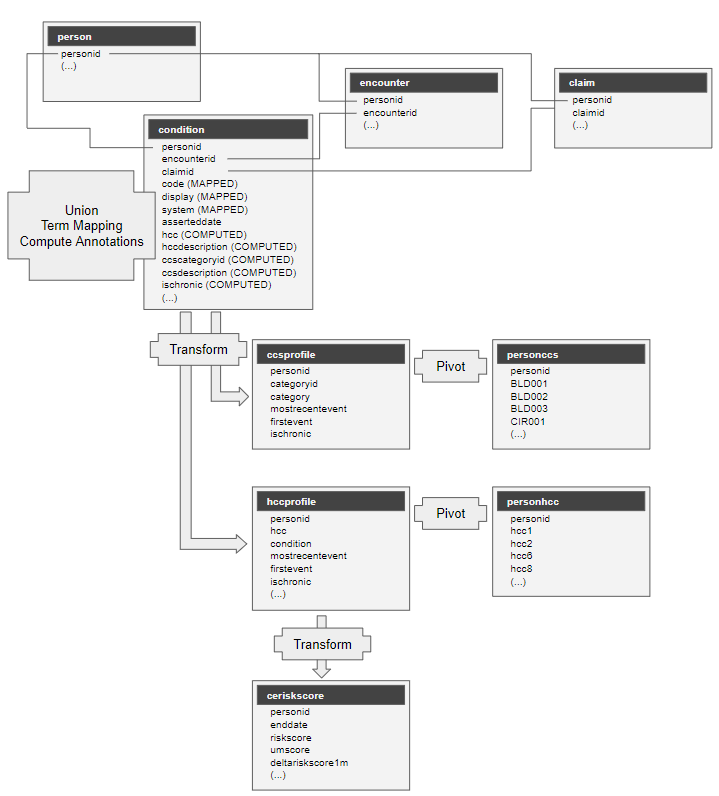Condition Profiles and Risk Score
Coded diagnoses from all claim-sourced and EHR-sourced data are transformed into condition profiles. These condition profiles roll-up coded diagnoses into high level categories and can be used to compute risk scores, population subsets based on condition criteria, disease registries, and care management opportunities.
All instances of coded diagnoses are expressed in the unified condition table. This table provides mappings to reference terminologies and a simplified reference the master person concept that links records across data sources.
All rows in the condition table are annotated with the associated Hierarchical Condition Category (HCC) as well as a condition category and a chronic condition indicator from CCSR.
Hierarchical Condition Categories are useful because they provide approximate 80 summary-level categories of disease that drive long term utilization of health care services. HCCs are devised to compute prospective risk scores used by CMS to estimate a beneficiary’s expected cost. Several disease categories are organized into a hierarchy to represent severity of disease. Because HCCs intend to represent diagnoses that relate to prospective utilization, most ICD10 codes do not roll up to an HCC.
In contrast, all diagnoses coded by ICD10 roll up to a condition category specified by CCSR (Clinical Classification Software Refined extends the original ICD9-based Clinical Classification Software to support ICD10). CCSR is ideal to represent the full spectrum of ICD10 codes in a high level roll up.
CCSR also labels all ICD10 codes with a Chronic Condition Indicator. Understanding which diagnoses may represent chronic conditions can be very useful when analyzing a population in many population health use cases.
External links:
- CMS Risk Adjustment (specifies HCCs)
- HCUP CCSR (Clinical Classifications Software Refined)
- HCUP CCI (Chronic Condition Indicator)
Tables in the Population Health Model
Individual instances of diagnoses in the condition table are transformed into higher order condition-based concepts in the following tables:
- hccprofile provides one row for each person + HCC. It is useful to determine all HCCs coded for a person, summarized with the first and most recent diagnosis date associated with the HCC.
- ccsprofile provides one row for each person + CCS category. It is useful to determine all CCS categories coded for a person, summarized with the first and most recent diagnosis date associated with the category.
- ceriskscore computes a trendable risk score for each person by calculating the risk score in each month based on the HCCs that would have been active at that time. HCCs from the hccprofile table are used to compute the risk score.
- personhcc is a pivoted representation of hccprofile. Each person is represented by one row. Each HCC is represented by a column that provides the date of the most recent diagnosis.
- personccs is a pivoted representation of ccsprofile. Each person is represented by one row. Each condition category is represented by a column that provides the date of the most recent diagnosis.
A conceptual data flow is described in the diagram below.
- Diagnoses integrated from claims and EHR data are unified in the condition table where they are represented using primary mapped terms.
- The condition table is annotated with HCC, CCSR, and CCI concepts.
- Conditions are summarized in the ccsprofile table using the CCSR algorithm, then pivoted (on categoryid) to the personccs table to provide a “one row per person” representation.
- Conditions are summarized in the hccprofile table using the HCC/RAPS algorithm, then pivoted (on hcc) to the personhcc table to provide a “one row per person” representation.
- Condition profiles are used to compute trendable, up-to-date risk scores in the ceriskscore table.
